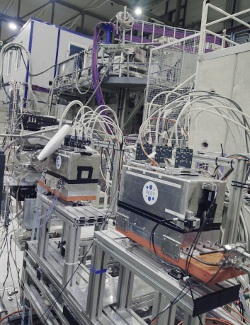 |
 |
|||||||||||||
|
|||||||||||||
|
|||||||||||||
|
Greek mythology, cartoon characters and plays on words – projects and collaborations in high-energy physics donít always conform to the stereotype of the incomprehensible acronym. If a new project to be submitted to the European Commission for funding, answering a call from it Seventh Framework programme (FP7), gets approval, the world of opera can be added to the list above. AIDA – for Advanced European Infrastructures for Detectors and Accelerators (the E from European is silent) – would draw together every group and project in Europe working on detector R&D for next-generation projects.
Coordinator for the proposal submitted on 2 December is Laurent Serin from LAL in Orsay, France, who is currently based at CERN as scientific associate. More than 100 scientists from 20 different European countries are involved in drafting the proposal that answers an FP7 call for advanced detector R&D for new accelerators. If approved, the total budget would amount to 30 million Euros over a period of four years with 10 million Euros expected from the European Commission (EC). It's not only scientists working on ILC detectors who are part of the project — the proposed LHC upgrade sLHC needs new detectors, as does CLIC, a planned SuperB factory and experiments with neutrinos at accelerators. AIDA is supposed to identify the synergies between different R&D groups and federate the European efforts. For example both sLHC and linear collider experiments will need outstanding pixel detectors, and AIDA makes sure that common infrastructures at beam test can be developed fulfilling both needs. “This level of cooperation has never been achieved before and it is one more step beyond the successful EUDET project in FP6 — we very much hope that the project gets approval,” explains Serin, himself an old hand in detector R&D as has worked on the ATLAS detector from its very beginning in 1991. The AIDA proposal aims to improve the key infrastructures required for detector development, with trans-national access to test-beams and irradiations facilities. It also includes networking activities for collaborative development of new technologies in software and microelectronics. To guarantee a coordination and continuation of the efforts, in view of an expected decision to start construction of large scale detectors for new experiments, a dedicated network also aims to enforce links with European industry. More specifically for the linear collider communities, common geometry description packages and particle analysis algorithms are expected to be developed in a way that can be used by all. On the detector side, some deliverables include improvement of the time projection chamber (TPC) development at DESY, infrastructure for silicon strips detectors and calorimeters (electromagnetic and hadronic for linear colliders), and finally a new pixel telescope (an extension of the existing EUDET telescope. This last example is a good example of synergy between the sLHC and linear collider communities: it will present two characteristics — a high readout rate, important for sLHC prototypes, and high accuracy, needed for linear collider experiments. These two qualities can be combined to provide both an impeccable alignment and real-life readout conditions to check prototypes against. If the proposal is successful, the project could start to be funded by EC by the end of next year. Check ILC NewsLine or the project webpage to get the submitted proposal of for news on its progress. -- Barbara Warmbein |
|||||||||||||
| © International Linear Collider |
